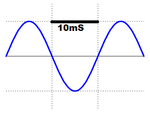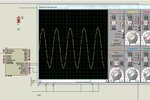Mithun_K_Das
Advanced Member level 3

- Joined
- Apr 24, 2010
- Messages
- 899
- Helped
- 24
- Reputation
- 48
- Reaction score
- 26
- Trophy points
- 1,318
- Location
- Dhaka, Bangladesh, Bangladesh
- Activity points
- 8,254
Generating Sine wave is very demanded job in power electronics field. So do to me too. I read some topics over the internet and found many ways to generate a sine wave. As most of you are really interested in generating sine wave so I’m writing today about it here.
There is some different ways out there to make a sine wave. Here I’m presenting one of my easiest one. To get this one all you need a micro-controller which have at-least 2 PWM/CCP module. But if you get the concept I’ll describe here then you can make it with your own code. So let’s see the concept generating a sine wave with two PWM/CCP module.
First of all, to get a sine wave we will need two SPWM signal. These two signals will generate sine wave after filtered with inductors and capacitors. But in between this signal and filters we need some kind of Transformer and to switch the transformer need some MOSFETs. Usually a H-Bridge will do the work for us. It will transform the DC power source being switched as per the SPWM signal that will flow through the Transformer. And from the output of the transformer we will get AC signal. And after filtering, we’ll get a pure sine wave signal.
Here is a basic H-Bridge circuit. And the image is describing itself what will happen and how we can get the AC signal from a DC signal.

OK, fine. Now lets see what is in a sine wave, a sine wave there is tow half signals. Each of these half signals consumes 10mS of time for 50Hz system. So if we wish to generate a sine wave of 50Hz, we need to do a full SPWM cycle in between this 10mS. My plan is simple. In this 10mS of time, all I need to do is taking a PWM signal and the duty cycle will be around zero at the starting point, almost full at the middle of this 10mS and then zero again at the end of the 10mS. This is simple. And if this can be done, after a filter with LC, we’ll get the result.
a sine wave there is tow half signals. Each of these half signals consumes 10mS of time for 50Hz system. So if we wish to generate a sine wave of 50Hz, we need to do a full SPWM cycle in between this 10mS. My plan is simple. In this 10mS of time, all I need to do is taking a PWM signal and the duty cycle will be around zero at the starting point, almost full at the middle of this 10mS and then zero again at the end of the 10mS. This is simple. And if this can be done, after a filter with LC, we’ll get the result.
In the mean time, we need to generate a square wave of 10mS duration. This is only for a half cycle. So to complete another half cycle, we need to do the same as we did for the first half but just reversed of the 10mS duration and same as PWM.
This will overload the MCU. So we have to make a table for PWM duty cycle. Here I’ll present a simplest one. Keep in mind that, “The more the number in the table, more the accuracy”.
sign_table[18] = {50,75,100,125,150,175,200,225,250,250,225,200,175,150,125,100,75,50};
We will use just 18 samples here as we are just doing the basic. And what the micro-controller have to do is, MCU will generate an interrupt of 555.55uS to execute this 18 samples twitch within that 10mS. So that the PWM duty cycle starts from low in the start of the half cycle, then maximum at the middle of the half cycle and then again low at the end of the half cycle. Thus a complete SPWM can be found. You can use Timer0 or Timer1 for this purpose. Then 18 sample will take around 10mS and twitch this sampling will make a complete cycle. Meanwhile, we will use a variable to count, when the count will be equal to 18, we’ll just reverse the clock order. Thus we will get two SPWM and two 50Hz push-pull signal. If you don’t understand why this 18 samples are taken then just look at the table. And you’ll find that, the duty cycle is maximum at the middle and lowest by the start and end. Then imagine what will happen if this digital signal is converter into analog signal, a sine wave….. Yes! It will be a sine wave.
So lets see the code here,
This code will generate the required signal. Also a LCD will be used to show some messages. After simulating the code with the circuit in proteus, we’ll get a result like this:

Now Our required signal is ready. All we need to do is to use these signals to drive the H-Bridge. Then the H-Bridge will switch a transformer and we will get an AC signal over the output of the Transformer. Then after filtering the signal, we will get the pure sine wave. Here is the rest of the circuit…


Bingo!!! We got the sine wave…!!!
This is the very basic way to generate sine wave. Now its your duty to use the concept. You can use it to design a pure sine wave inverter for yourself or as your wish. Its all yours.
Thank you all. If you need any further help, please contact with me. For more please visit my blog: **broken link removed** or visit my facebook page: www.facebook.com/mlabsbd.
There is some different ways out there to make a sine wave. Here I’m presenting one of my easiest one. To get this one all you need a micro-controller which have at-least 2 PWM/CCP module. But if you get the concept I’ll describe here then you can make it with your own code. So let’s see the concept generating a sine wave with two PWM/CCP module.
First of all, to get a sine wave we will need two SPWM signal. These two signals will generate sine wave after filtered with inductors and capacitors. But in between this signal and filters we need some kind of Transformer and to switch the transformer need some MOSFETs. Usually a H-Bridge will do the work for us. It will transform the DC power source being switched as per the SPWM signal that will flow through the Transformer. And from the output of the transformer we will get AC signal. And after filtering, we’ll get a pure sine wave signal.
Here is a basic H-Bridge circuit. And the image is describing itself what will happen and how we can get the AC signal from a DC signal.

OK, fine. Now lets see what is in a sine wave,
 a sine wave there is tow half signals. Each of these half signals consumes 10mS of time for 50Hz system. So if we wish to generate a sine wave of 50Hz, we need to do a full SPWM cycle in between this 10mS. My plan is simple. In this 10mS of time, all I need to do is taking a PWM signal and the duty cycle will be around zero at the starting point, almost full at the middle of this 10mS and then zero again at the end of the 10mS. This is simple. And if this can be done, after a filter with LC, we’ll get the result.
a sine wave there is tow half signals. Each of these half signals consumes 10mS of time for 50Hz system. So if we wish to generate a sine wave of 50Hz, we need to do a full SPWM cycle in between this 10mS. My plan is simple. In this 10mS of time, all I need to do is taking a PWM signal and the duty cycle will be around zero at the starting point, almost full at the middle of this 10mS and then zero again at the end of the 10mS. This is simple. And if this can be done, after a filter with LC, we’ll get the result.In the mean time, we need to generate a square wave of 10mS duration. This is only for a half cycle. So to complete another half cycle, we need to do the same as we did for the first half but just reversed of the 10mS duration and same as PWM.
This will overload the MCU. So we have to make a table for PWM duty cycle. Here I’ll present a simplest one. Keep in mind that, “The more the number in the table, more the accuracy”.
sign_table[18] = {50,75,100,125,150,175,200,225,250,250,225,200,175,150,125,100,75,50};
We will use just 18 samples here as we are just doing the basic. And what the micro-controller have to do is, MCU will generate an interrupt of 555.55uS to execute this 18 samples twitch within that 10mS. So that the PWM duty cycle starts from low in the start of the half cycle, then maximum at the middle of the half cycle and then again low at the end of the half cycle. Thus a complete SPWM can be found. You can use Timer0 or Timer1 for this purpose. Then 18 sample will take around 10mS and twitch this sampling will make a complete cycle. Meanwhile, we will use a variable to count, when the count will be equal to 18, we’ll just reverse the clock order. Thus we will get two SPWM and two 50Hz push-pull signal. If you don’t understand why this 18 samples are taken then just look at the table. And you’ll find that, the duty cycle is maximum at the middle and lowest by the start and end. Then imagine what will happen if this digital signal is converter into analog signal, a sine wave….. Yes! It will be a sine wave.
So lets see the code here,
Code C - [expand]
This code will generate the required signal. Also a LCD will be used to show some messages. After simulating the code with the circuit in proteus, we’ll get a result like this:

Now Our required signal is ready. All we need to do is to use these signals to drive the H-Bridge. Then the H-Bridge will switch a transformer and we will get an AC signal over the output of the Transformer. Then after filtering the signal, we will get the pure sine wave. Here is the rest of the circuit…


Bingo!!! We got the sine wave…!!!
This is the very basic way to generate sine wave. Now its your duty to use the concept. You can use it to design a pure sine wave inverter for yourself or as your wish. Its all yours.
Thank you all. If you need any further help, please contact with me. For more please visit my blog: **broken link removed** or visit my facebook page: www.facebook.com/mlabsbd.


